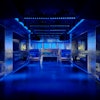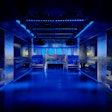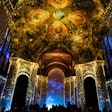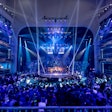I love peonies. But so did one of the New York elite characters in Dominick Dunne’s underrated and infinitely mineable novel People Like Us. Not only did he end up dead of AIDS, his own mother discarded whatever plate he ate off, no matter the value, when he left her house, rather than keep the supposedly diseased thing around.
Let’s start over. Do I love the Plaza Hotel? I think I did. In high school, I’d sneak into the Oak Room for drinks and consider myself cosmopolitan and worldly, not knowing that the dark, high-ceilinged watering hole was already overrun by high-end hookers and the mid-level men who admired them.
In college, friends from all over the East Coast would gather at Trader Vic's, the Polynesian place that used to be downstairs—the one New York landmark that even the hickest could locate.
In my professional life, I threw a number of big events at the Plaza, and they all worked—despite a couple things: I found Ivana’s makeover garish, the food was mediocre (though the ancient staff was efficient, if not elegant), and I would go out of my way to recommend visitors not staying there. (The rooms, even some of the big suites, were dowdy, and despite the views, somehow depressing.)But the Plaza is back, I suppose. After a multimillion-dollar makeover and condo conversion, it was tapped by the Society of Memorial Sloan-Kettering Cancer Center, perhaps the city’s most socially prestigious and scientifically important medical institution, as the venue for the reincarnation of its biggest annual fund-raiser. The event raised nearly $3 million, and tables cost $15,000 and up. People not like us, if you will.
Their previous big-ticket night was an award gala, which I covered last season in this space. The society decided the event was getting boring, so they risked tossing baby with bathwater by canceling their known moneymaker and creating a completely new annual benefit.
“We were known for our serious and thoughtful awards. But at this point, doesn’t everyone respect MSK’s work?” explained event co-chair Muffie Potter Aston. “So we decided to create an annual Spring Ball, and to focus on the festive.”
So “Festive Black Tie” was the dress code—which I personally get scared by, always thinking I should find an outfit leftover by Carmen Miranda. I settled on a pale pink formal shirt and a patterned bower that I got in Palm Beach. I realized a bit too late that, at least for this crowd, festive meant the women only; the chairs had all plotted out their pastels, which made for a unmistakable host greeting area as well as a guaranteed New York Times Sunday picture. The men wore black and white, and I felt like an idiot.
They hired my favorite DJ, Tom Finn. (He often wisely kicks off with Barry White, as he did here, which worked on this near geriatric crowd.) But the real surprise was both the choice and success of singer Natasha Bedingfield, who rocked the house and had everyone on their feet and moving. “Rare, isn’t it?” I asked Muffie. “For this crowd, you bet,” she responded.
Is it clear I’m reporting a success? The upstairs ballroom hallway was filled with giant spherical pink peony arrangements, designed by David Beahm, which owed as much credit to Dr. Seuss as to Edith Wharton. The big room was decorated with Chinese lanterns in equally vivid colors. Both installations worked for the same reasons. The lighting was tight and emphasized the colors. The scale of the decor matched the size and drama of the setting (the Plaza has always exuded drama), and then some. I’ve never seen Chinese lanterns this big, and I’ve seen almost everything.
The tables tried two innovations. Programs were placed upright at every other place only and the rest were on the seats—which cleared up eye clutter and made negotiating seating easier. Napkins were trifolded lengthwise, but left long, with half the length hanging over the table’s edge—which added eye clutter and made negotiating seating more difficult.
What I saw of the Plaza redo pleased the eye, but I have quibbles. (Don’t I always?) The Trump gilding has given way to pale marbles and quieter fabrics (thank God). But the entry porte cochere and the abutting Grand Army Plaza have lost the sense of New York City action that the hotel used to convey. Gone are the taxis, and the limos waiting are not for glamorous guests but for local businessmen whose drivers have figured out that the city’s loss is their gain. I saw one guy cooling his heels for quite a while, finally moving only when Henry Kravis jumped in.
Likewise, the busy lobby limps, the Palm Court didn’t dazzle, and the staff seemed a little rusty at handling the fancies, herding guests into two small elevators next to some black pipe and drape that screamed, “Please, please hide me with one of the potted palms of the old Plaza!”
Let’s start over. Do I love the Plaza Hotel? I think I did. In high school, I’d sneak into the Oak Room for drinks and consider myself cosmopolitan and worldly, not knowing that the dark, high-ceilinged watering hole was already overrun by high-end hookers and the mid-level men who admired them.
In college, friends from all over the East Coast would gather at Trader Vic's, the Polynesian place that used to be downstairs—the one New York landmark that even the hickest could locate.
In my professional life, I threw a number of big events at the Plaza, and they all worked—despite a couple things: I found Ivana’s makeover garish, the food was mediocre (though the ancient staff was efficient, if not elegant), and I would go out of my way to recommend visitors not staying there. (The rooms, even some of the big suites, were dowdy, and despite the views, somehow depressing.)But the Plaza is back, I suppose. After a multimillion-dollar makeover and condo conversion, it was tapped by the Society of Memorial Sloan-Kettering Cancer Center, perhaps the city’s most socially prestigious and scientifically important medical institution, as the venue for the reincarnation of its biggest annual fund-raiser. The event raised nearly $3 million, and tables cost $15,000 and up. People not like us, if you will.
Their previous big-ticket night was an award gala, which I covered last season in this space. The society decided the event was getting boring, so they risked tossing baby with bathwater by canceling their known moneymaker and creating a completely new annual benefit.
“We were known for our serious and thoughtful awards. But at this point, doesn’t everyone respect MSK’s work?” explained event co-chair Muffie Potter Aston. “So we decided to create an annual Spring Ball, and to focus on the festive.”
So “Festive Black Tie” was the dress code—which I personally get scared by, always thinking I should find an outfit leftover by Carmen Miranda. I settled on a pale pink formal shirt and a patterned bower that I got in Palm Beach. I realized a bit too late that, at least for this crowd, festive meant the women only; the chairs had all plotted out their pastels, which made for a unmistakable host greeting area as well as a guaranteed New York Times Sunday picture. The men wore black and white, and I felt like an idiot.
They hired my favorite DJ, Tom Finn. (He often wisely kicks off with Barry White, as he did here, which worked on this near geriatric crowd.) But the real surprise was both the choice and success of singer Natasha Bedingfield, who rocked the house and had everyone on their feet and moving. “Rare, isn’t it?” I asked Muffie. “For this crowd, you bet,” she responded.
Is it clear I’m reporting a success? The upstairs ballroom hallway was filled with giant spherical pink peony arrangements, designed by David Beahm, which owed as much credit to Dr. Seuss as to Edith Wharton. The big room was decorated with Chinese lanterns in equally vivid colors. Both installations worked for the same reasons. The lighting was tight and emphasized the colors. The scale of the decor matched the size and drama of the setting (the Plaza has always exuded drama), and then some. I’ve never seen Chinese lanterns this big, and I’ve seen almost everything.
The tables tried two innovations. Programs were placed upright at every other place only and the rest were on the seats—which cleared up eye clutter and made negotiating seating easier. Napkins were trifolded lengthwise, but left long, with half the length hanging over the table’s edge—which added eye clutter and made negotiating seating more difficult.
What I saw of the Plaza redo pleased the eye, but I have quibbles. (Don’t I always?) The Trump gilding has given way to pale marbles and quieter fabrics (thank God). But the entry porte cochere and the abutting Grand Army Plaza have lost the sense of New York City action that the hotel used to convey. Gone are the taxis, and the limos waiting are not for glamorous guests but for local businessmen whose drivers have figured out that the city’s loss is their gain. I saw one guy cooling his heels for quite a while, finally moving only when Henry Kravis jumped in.
Likewise, the busy lobby limps, the Palm Court didn’t dazzle, and the staff seemed a little rusty at handling the fancies, herding guests into two small elevators next to some black pipe and drape that screamed, “Please, please hide me with one of the potted palms of the old Plaza!”
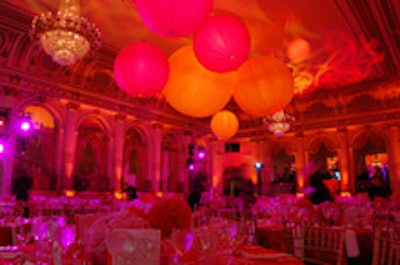
The Memorial Sloan-Kettering Cancer Center's Spring Ball.
Photo: Jessica Torossian for BizBash
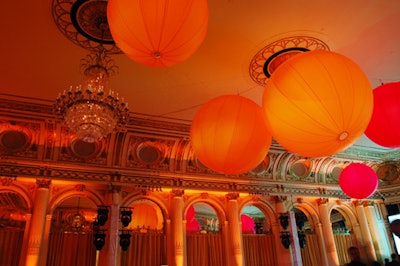
Giant Chinese lanterns designed by David Beahm illuminated the room.
Photo: Jessica Torossian for BizBash
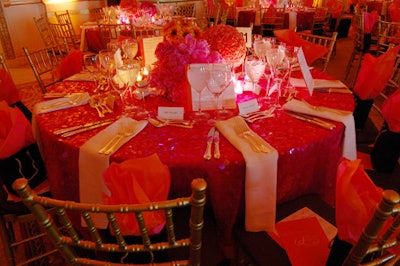
The tables took a unique approach, with programs placed upright at every other place setting and folded napkins hanging over the edges.
Photo: Jessica Torossian for BizBash
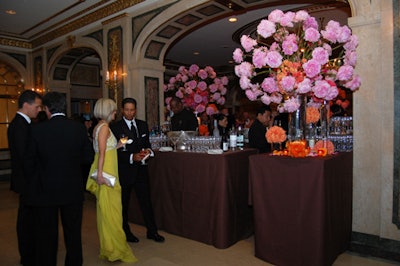
Large pink peony arrangements greeted guests, furthering the festive, springtime feel of the event.
Photo: Jessica Torossian for BizBash
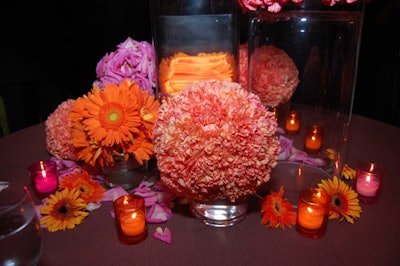
Smaller orange and pink peonies were placed at the base of the larger arrangements, mirroring the spherical design.
Photo: Jessica Torossian for BizBash
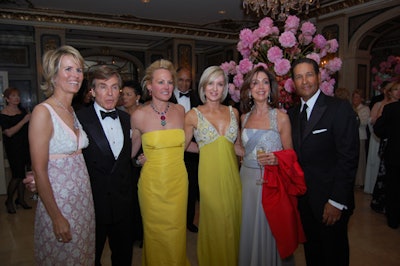
The socialite-studded bash included (from left) the Society of MSKCC president Leslie Jones, Dr. Sherrell Aston, event chair Muffie Potter Aston, Hilary Quinlan, Robyn Josephs, and Bryant Gumbel.
Photo: Jessica Torossian for BizBash

The dinner, which raised almost $3 million, was held in the Plaza Hotel's grand ballroom.
Photo: Jessica Torossian for BizBash


